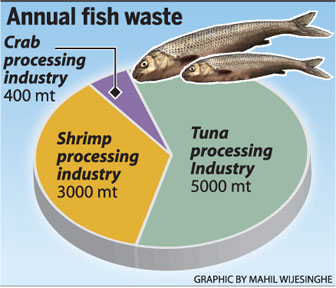ITI project adds value to fish waste
A total of 50-60 percent of the annual fish harvest is discarded as
fish waste or by-products due to the processing methods practiced by the
industry. This leads to environmental problems and disturbance of off
shore fishing activities.
Fish heads, viscera (gut) gills, skin and fins are discarded as fish
waste. ITI and with the Norwegian Institute of Fisheries and Aquaculture
Research under a NORAD funded project commenced a project to find
methods to add value to fish waste.
 Prior to the implementation of the project the fish waste collected
in the harbours too were dumped into the sea causing environmental and
other problems. Prior to the implementation of the project the fish waste collected
in the harbours too were dumped into the sea causing environmental and
other problems.
At the Beruwela harbour alone 700 kilos of waste per day was thrown
to the deep sea and it is no different to other harbours. After the
conflict, Kalmunai has a waste accumulation of 500-2,500 metric tons per
day depending on the season, said Research Scientist ITI, Samantha
Madage.
The ITI researched on methods to add value to the waste depending on
the quality and type of the waste. Madage said that the tuna processing
industry discards 40-50 percent as waste or by-products of which 30
percent can be consumed by humans which includes off cuts and the red
meat.
All this is sold to buyers in bulk form where the offcuts are dried
to be used as dried fish while the balance is dumped on bare lands or to
the sea.
Even poor quality and un fit for human consumption parts can be used
to produce animal feed and feed ingredients including fish silage, an
alternative to fish meal. Earlier there was no production of fish meal
locally therefore the total requirement had to be imported which was a
huge drain on foreign exchange. It is a major protein source in animal
feed and is very expensive.
The basic quality imported fish meal is Rs 340 a kilogram. Every part
of the fish can be used to manufacture fish silage which comes in liquid
form, which is a diet for pigs, poultry and fish.
The advantages of manufacturing fish silage locally are many. The
investment as well as the cost of production is very low, said Madage.
ITI has transferred this technology to the Beruwela harbour and has
further developed it as a powder using another waste material - rice
bran. It can be added to any form of feed. Other products which the ITI
has developed include bone meal, bone powder, gelatine from tuna skin,
fish oil, designer eggs and fish balls.
Madage said that some of the processes are patented while some
technologies have been transferred to companies for commercial
production.
Most of the technologies developed by the ITI are on low investment,
therefore even a small-scale entrepreneur can purchase and start
commercial production which will save foreign exchange and make the
country more environmental-friendly.
SG
|

